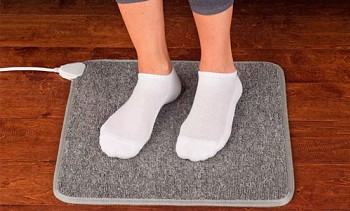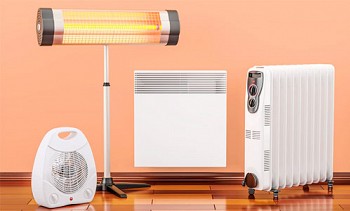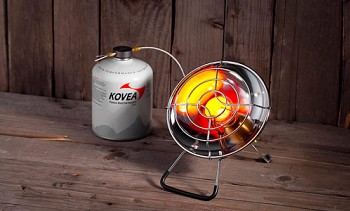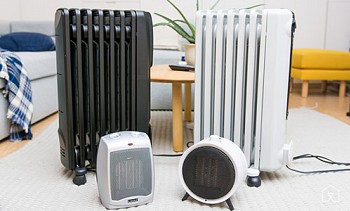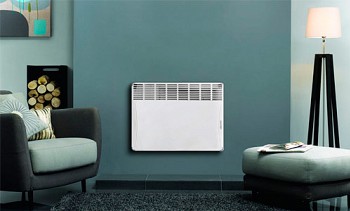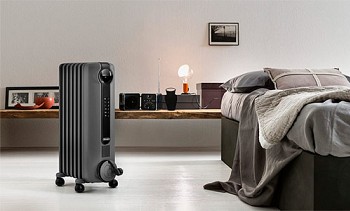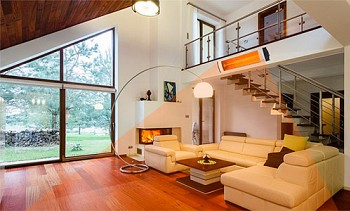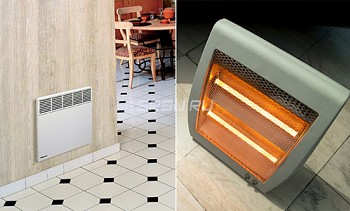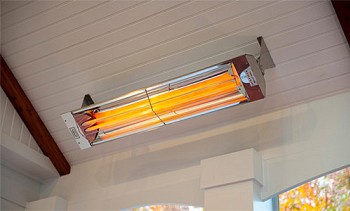The principle of operation of an infrared heater is based on the transmission of electromagnetic radiation from a source to surrounding objects. Once on a surface that is capable of absorbing IR radiation, turning it into thermal energy, such a device produces air heating in the room through convection processes of heat exchange from heated objects. Given the specifics of radiation, only 10% of the energy of infrared heaters is spent on raising the air temperature, all the rest goes on heating the objects in front of the device. For those who want to better understand the technical characteristics of infrared heaters, we have prepared this material.
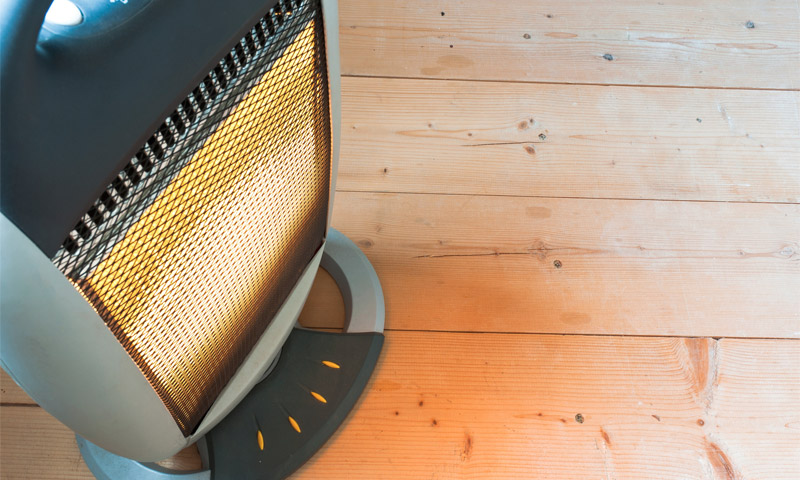
Content:
Infrared heater device
Infrared heaters have not only several designs (we will talk about this later), but also several operating principles, each of which is based on infrared radiation. Consider the technical characteristics of each of these IR heaters.
IR heater with heating panel

- 1. LED indicator of activity;
- 2. The element that generates infrared rays;
- 3. Product body;
- 4. Ceramic internal heat insulator;
- 5. A coupling plate;
- 6. The plate radiating heat.
This type of device produces heating in the classical way - thermal convection. This happens with the help of secondary thermal radiation, which it produces by heating with IR waves one of its structural elements - the front panel. This is not too effective, but it eliminates the problem of too close sources of open infrared radiation and their effect on the human body.
IR heater with reflector, without heating panel

- 1. Heater housing;
- 2. Protective grille;
- 3. Power regulator;
- 4. The element generating infrared rays;
- 5. Heater reflector.
The appliance heats by directional infrared radiation. Reflector - reflector, made of metal, most often aluminum. Its surface is carefully polished. Designed for the formation and intensification of the IR radiation flux and localization of the heating zone.
In addition to the listed components, there are several more nodes that are included in most standard heaters. This is a thermostat, which can be either electronic or mechanical. The device is designed to control the set temperature. Manufacturers can set up a temperature-sensitive sensor to take readings from various objects, they can be the radiation source itself, its body or an external object.
Gas IR heater

- 1. Reflector;
- 2. Power regulator;
- 3. Gas burner;
- 4. A connecting rod through which gas is supplied;
- 5. The base of the heater.
A feature of these IR heaters is that they are completely autonomous. During gas combustion, a radiating element is heated over which there is a reflector. IR waves are reflected from the reflector and sent to the space where the reflector is directed. This type of infrared heaters burns oxygen.
Structural designs of IR heaters
According to the principle of placement in the room or outside it (installation method), infrared heaters are divided into floor, wall and ceiling.
Floor IR heaters
Floor - usually they are portable, most models have a purely functional design, are equipped with a carrying handle and a special compartment for the cord.Such devices are used exclusively as auxiliary heat sources.
IMPORTANT! When choosing a portable model, you need to pay attention to whether the compartment overheating the cord is not overheating. Protective wiring may melt.
Heavy-duty models with significant weight are additionally equipped with wheels to facilitate transport. Most powerful floor models come standard with a rollover protection system. But the thermostat and remote control are only for premium products.

Varieties of floor IR heaters.
Wall mounted IR heaters
Wall-mounted infrared heaters, whose performance characteristics can be compared with centralized water heating radiators, are installed in the same places. These devices are complete heating appliances. A large power and radiation area implies significant weight, but this indicator is not so important for stationary use devices.
When choosing such devices, you should pay attention to the presence of a variety of control and safety systems:
- Programmable thermostat, on which you can set not only the temperature mode, but also the heater on time;
- Radiator overheat protection system.
Manufacturers pay special attention to the appearance of such heaters. The surface of the panel can be decorated with stylized drawings, as well as quite decent original paintings applied by airbrushing. Some models are finished with natural stone or Tibetan salt. But such decorations, in addition to significantly increasing the cost of a heating device, reduce its effectiveness, and paint can produce harmful fumes when heated.

Wall mounted IR heater.
Ceiling IR heaters
Ceiling heaters have a unitary, functional look that is difficult to fit into an elegant interior. They are mainly used in commercial and office premises, in open areas of street cafes. Given the specifics of use, many manufacturers are developing models with special fasteners that are compatible with fasteners and Armstrong ceiling standards. In everyday life they are used in cottages, garages or workshops. A very promising area of use is heating greenhouses in early spring and late autumn, which can significantly extend the period of ripening and harvesting.

Varieties of ceiling IR heaters.
Wavelength and dependence on it, temperature of the heating element
From the course of physics it is known that infrared radiation is in the range of 0.75-1000 μm.

Manufacturers of infrared heaters divided this range into three sectors. This is because the operating temperature of the heating element depends on the wavelength.
1. At a temperature of the heating element from 100 to 600 0FROM - the emitter operates in the long-wavelength range of 5.6 - 100 μm. Such devices are considered low temperature. They are intended for residential premises, in which the ceiling height is limited to 3 m. As a rule, the power and temperature of such models is limited to 120 ºС.
2. When the temperature of the heating element is from 600 - 1000 0FROM - the average wave range of 1.5-5.6 microns. Devices with such performance indicators are used in high-ceilinged rooms of 3-6 m. These are usually private houses of old construction or public buildings.
3. Heating temperature more than 1000 ºС - heaters use a short-wave range of infrared waves of 0.75-1.5 microns. They are used for heating rooms with ceilings of 6-8 m: warehouses, hangars, assembly shops or for heating on the street.
The dependence of temperature on the power model
Power 100-400 W. Devices of such power include heating devices of the so-called "soft heat", the maximum temperature of which reaches 60º. The heater can be used in humid conditions up to 100%. In addition, heaters of this type are recommended to be used in preschool educational institutions, so that children can not get hurt.
Power 400-600 W, temperature is from 60 to 100 ºС. Designed, for the most part, for installation in offices. Some heaters have Armstrong ceiling mounts. Metal housings with various protection from IP55 to IP21.
Power 600-1000 W at a temperature of 101-280 ºС. Infrared heaters, the technical characteristics of which are limited by this temperature, are produced by many companies. Devices are designed to create warm curtains over windows or doorways.
Power over 1000 W surface temperature more than 300 ºС. Mainly intended for external use for heating outdoor terraces, conservatories, balconies.
Types of heating elements and their characteristics
Ceramic heating element
The ceramic panel heats up thanks to a high-resistance metal thread. Due to the effect of magnetic induction, the thread not only informs the ceramic panel of the temperature, but also the momentum for the emission of infrared waves. Due to the design features, the bath type of generation of infrared waves can only be used in wall and ceiling models.

Ceramic emitter.
Halogen heating element
IR waves are induced by a halogen lamp. The devices have compact dimensions and high power quickly heat the room, can be used on the street. The most common models of manufacturers: Neoclima, Ballu, General Climate.
A significant drawback of these devices is that during operation they glow quite brightly.

Halogen infrared emitter.
Tubular heating element based on quartz and carbon lamps
IR radiation is generated in a spectrum invisible to the human eye. The most popular manufacturers: Electrolux, Frico, Adax, Hintek, Timberk, Simbo. They have a relatively low power consumption. Due to their compact size, several rods can be mounted in one generating panel, which significantly increases its efficiency. Among the disadvantages, it should be noted the high cost of products based on carbon elements.

Tubular emitter.
Gas burner based IR emitter
This device has a double principle of operation. Gas, burning, heats the radiating element around which the reflector is located. Infrared waves reflected from it form a thermal dome or field depending on the model and the direction of reflection of the reflector.
Devices of this type are completely autonomous of which can be used in hiking and in cottages where there is no electricity. Even compact models are very effective; they can be safely used in case of emergency shutdown of heat supply in winter. Brand devices are equipped with various security systems that will turn off the gas supply if the fire goes out or the amount of carbon monoxide in the room exceeds the norm. In addition, for ease of use, they are equipped with a built-in piezo ignition.

Gas infrared heater.
Advantages and disadvantages of IR heaters

+ Benefits:
- High energy efficiency.
- Fast and soft heating of all objects in the area of effect.
- Unlike convection devices, it does not raise dust.
- The ability to adjust the heating zone.
- Do not dry air and do not burn oxygen. This is true only for electric IR generators. It is better to refrain from using autonomous gas generators in a small room.
- Many models "specialize" in heating rooms with high ceilings.

– Disadvantages:
- All devices of this type are completely autonomous, even in one apartment it is still difficult to unite them in a single network. Have to type commands for each heater separately.
- Some models crack when heating and cooling - this is due to the fact that metals with different degrees of expansion during heating and cooling (steel + aluminum) are used to manufacture the device.

